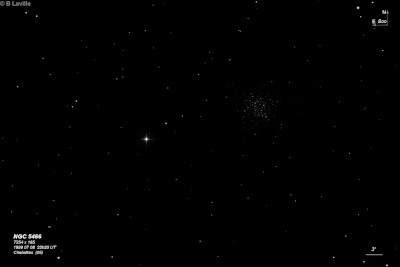
William Herschel discovered NGC 5466 = H VI-9 = h1746 on 17 May 1784 (sweep 219) and recorded "a large cluster of exceedingly small and compressed stars, about 6 or 7' in dia; a great many of the stars are visible, the rest so small as to appear nebulous; those that are visible are of one size and are scattered all over equally. The cluster is of an irregularly round form." The globular was placed in classification category VI for "very condensed and rich clusters of stars", although it is an unusually loose globular. On 16 May 1831 JH described the cluster as "a fine L cl 7 or 8' dia; vgbM, but no nucleus. The stars 11 or 12m down to an irresolvable mass; irreg R; excessively compressed. A fine object. Barely discernible in the 20 feet finder (2 1/2" in aperture)." Wolfgang Steinicke notes that Heinrich d'Arrest observed it twice in 1856 using a 4.6-inch Merz refractor in Leipzig.
200/250mm - 8" (6/5/81): fairly large, low surface brightness with a "loose" structure. A few faint stars are resolved across the disk at 100-165x.
300/350mm - 13.1" (5/26/84): roughly three dozen stars resolved about 14th magnitude. Visible in 18x80 finder.
13.1" (5/14/83): few dozen mag 14 stars resolved across disc over extensive background haze.
400/500mm - 17.5" (6/3/00): large, low surface brightness globular, 7'-8' in diameter. Has a ragged, irregular surface brightness to the core and halo. About 50-60 mag 14-15.5 stars are resolved at 280x-380x. The brighter core is relatively large, perhaps 4' in diameter and appears offset to the west side of the resolved stars. Many faint stars are peppered across the core.
17.5" (6/6/86): 40-50 mag 14-15 stars resolved at 220x in a 7' diameter. Very spread out like a fairly rich open cluster with no distinct edges and only a weak concentration.
900/1200mm - 48" (4/19/17): at 375x; very large, highly resolved cluster with chains of brighter stars, particularly in the halo, which extends to at least 8', but also passing through the richer 3' to 4' central section. The surface brightness is relatively low due its loose structure (concentration class XII), even in the core. The brighter stars seems superimposed over a layer of much fainter resolved stars. At 697x, there were way too many visible stars for a reasonably accurate count but perhaps around 250 stars resolved.
Notes by Steve Gottlieb